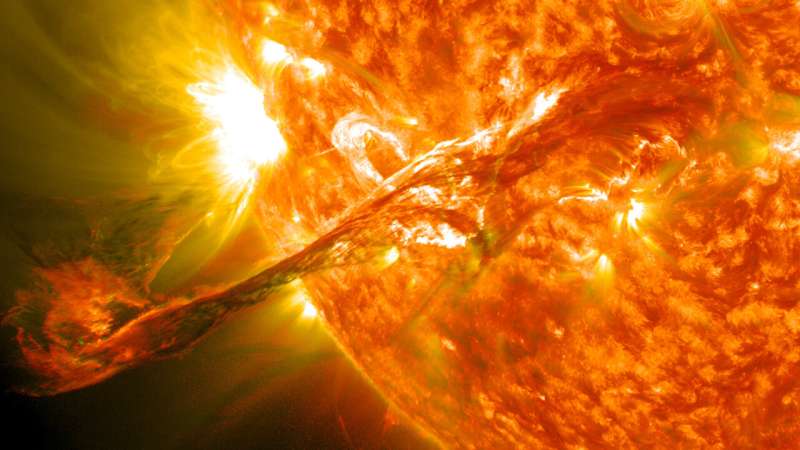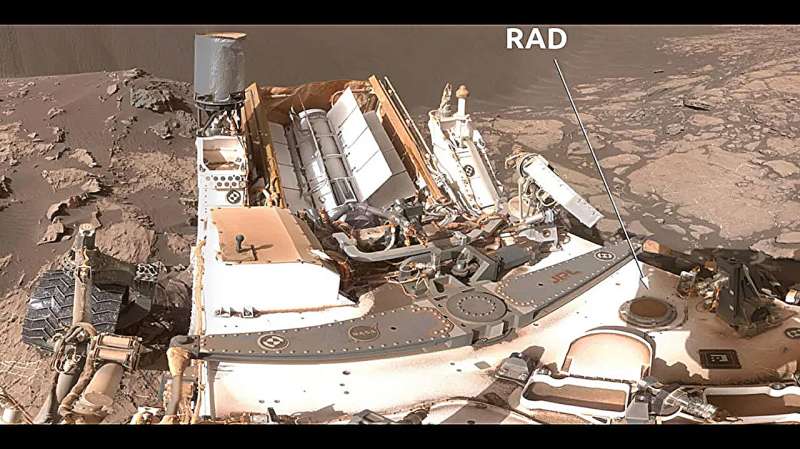This article has been reviewed according to Science X's editorial process and policies. Editors have highlighted the following attributes while ensuring the content's credibility:
fact-checked
trusted source
proofread
NASA scientists gear up for solar storms at Mars

In the months ahead, two of NASA's Mars spacecraft will have an unprecedented opportunity to study how solar flares—giant explosions on the sun's surface—could affect robots and future astronauts on the Red Planet.
That's because the sun is entering a period of peak activity called solar maximum, something that occurs roughly every 11 years. During solar maximum, the sun is especially prone to throwing fiery tantrums in a variety of forms—including solar flares and coronal mass ejections—that launch radiation deep into space. When a series of these solar events erupts, it's called a solar storm.
Earth's magnetic field largely shields our home planet from the effects of these storms. But Mars lost its global magnetic field long ago, leaving the Red Planet more vulnerable to the sun's energetic particles. Just how intense does solar activity get on Mars? Researchers hope the current solar maximum will give them a chance to find out. Before sending humans there, space agencies need to determine, among many other details, what kind of radiation protection astronauts would require.
"For humans and assets on the Martian surface, we don't have a solid handle on what the effect is from radiation during solar activity," said Shannon Curry of the University of Colorado Boulder's Laboratory for Atmospheric and Space Physics. Curry is principal investigator for NASA's MAVEN (Mars Atmosphere and Volatile EvolutioN) orbiter, which is managed by NASA's Goddard Space Flight Center in Greenbelt, Maryland. "I'd actually love to see the 'big one' at Mars this year—a large event that we can study to understand solar radiation better before astronauts go to Mars."
Measuring high and low
MAVEN observes radiation, solar particles, and more from high above Mars. The planet's thin atmosphere can affect the intensity of the particles by the time they reach the surface, which is where NASA's Curiosity rover comes in. Data from Curiosity's Radiation Assessment Detector, or RAD, has helped scientists understand how radiation breaks down carbon-based molecules on the surface, a process that could affect whether signs of ancient microbial life are preserved there. The instrument has also provided NASA with an idea of how much shielding from radiation astronauts could expect by using caves, lava tubes, or cliff faces for protection.
When a solar event occurs, scientists look both at the quantity of solar particles and how energetic they are.
"You can have a million particles with low energy or 10 particles with extremely high energy," said RAD's principal investigator, Don Hassler of the Boulder, Colorado, office of the Southwest Research Institute. "While MAVEN's instruments are more sensitive to lower-energy ones, RAD is the only instrument capable of seeing the high-energy ones that make it through the atmosphere to the surface, where astronauts would be."
When MAVEN detects a big solar flare, the orbiter's team lets the Curiosity team know so they can watch for changes in RAD's data. The two missions can even assemble a time series measuring changes down to the half-second as particles arrive at the Martian atmosphere, interact with it, and eventually strike the surface.
The MAVEN mission also leads an early warning system that lets other Mars spacecraft teams know when radiation levels begin to rise. The heads-up enables missions to turn off instruments that could be vulnerable to solar flares, which can interfere with electronics and radio communication.

Lost water
Beyond helping to keep astronauts and spacecraft safe, studying solar maximum could also lend insight into why Mars changed from being a warm, wet Earth-like world billions of years ago to the freezing desert it is today.
The planet is at a point in its orbit when it's closest to the sun, which heats up the atmosphere. That can cause billowing dust storms to blanket the surface. Sometimes the storms merge, becoming global.
While there's little water left on Mars—mostly ice under the surface and at the poles—some still circulates as vapor in the atmosphere. Scientists wonder whether global dust storms help to eject this water vapor, lofting it high above the planet, where the atmosphere gets stripped away during solar storms. One theory is that this process, repeated enough times over eons, might explain how Mars went from having lakes and rivers to virtually no water today.
If a global dust storm were to occur at the same time as a solar storm, it would provide an opportunity to test that theory. Scientists are especially excited because this particular solar maximum is occurring at the start of the dustiest season on Mars, but they also know that a global dust storm is a rare occurrence.
Provided by NASA





















